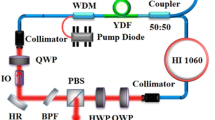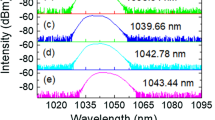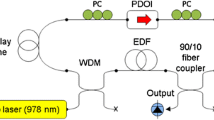Abstract
A tunable dual- and triple-wavelength passively mode-locked ytterbium-doped fiber laser in the all-normal-dispersion regime is reported and demonstrated. Using a phase-shifted long-period fiber grating as an all-fiber format spectral filter in the laser cavity, a self-starting stabilized multi-wavelength mode-locking operation is achieved by nonlinear polarization evolution. The mode-locked multi-wavelength output can be tuned continuously and smoothly over a spectral range of 10 nm using the phase-shifted long-period fiber grating bandpass filter without re-adjusting any elements in the system. It opens a new possibility to achieve tunable and controllable multi-wavelength mode-locked high-energy laser output in the all-normal-dispersion cavity in an all-fiber format.
Similar content being viewed by others
Avoid common mistakes on your manuscript.
1 Introduction
Tunable multi-wavelength and mode-locked fiber lasers have many potential applications in the fields of wavelength-division-multiplexing optical fiber communication, optical fiber sensing, and fiber device testing. Dual-wavelength laser outputs have been generated in both actively and passively mode-locked fiber lasers based on either erbium-doped fiber [1, 2], semiconductor optical amplifier [3], highly nonlinear fiber [4], polarization maintaining fibers [5] or modulation instability [6], and four-wave mixing [7]. Yang et al. [8] reported a multi-wavelength actively mode-locked fiber laser using an integrated cascaded sampled fiber Bragg gratings in the cavity. Pan et al. [9] reported a dual- and five-wavelength actively mode-locked erbium-doped fiber laser by virtue of the nonlinear polarization rotation effect. Although the actively mode-locked fiber lasers have advantages such as high repetition rates, narrow linewidth, and large number of wavelengths, it suffers from the drawbacks of weak peak power, cost inefficiency, and high insertion loss because of modulators incorporated in the cavity. The passively mode-locked fiber laser can also be used to generate multi-wavelength pulses [5, 10–12]. Gong et al. [5] reported a fixed dual-wavelength operation in a passively mode-locked erbium-doped fiber ring laser by incorporating two sections of polarization maintaining fibers. Liu et al. [10, 11] reported multiple-wavelength output with different pulse durations in erbium-doped fiber lasers using graphene and single-walled carbon nanotubes. In Song et al. [12] reported a tunable dual-wavelength passively mode-locked soliton in erbium-doped fiber by the nonlinear polarization rotation effect. However, the dual-wavelength output is not predicable because the soliton wavelength is arbitrarily determined by the polarization state in the cavity.
Recently, all-normal-dispersion (ANDi) fiber lasers have attracted great interest because of their simple cavities and high pulse energies [13–18]. Zhang et al. [16] reported a multi-wavelength dissipative soliton operation of an erbium-doped fiber laser in which mode locking of the laser was achieved with a semiconductor saturable absorber mirror, and the multi-wavelength was generated by the existence of an “artificial” birefringence filter in the laser cavity resulting from the residual polarization asymmetry of the components. The dual- or triple-wavelength pulses of the laser are randomly distributed over a time sequence because of the different group velocities of the different solitons in the cavity, and the wavelength position of each of the solitons is not fixed and controllable but distributed within the gain bandwidth depending on the applied strength of the birefringence of the cavity.
In this paper, a novel tunable dual- and triple-wavelength passively mode-locked ANDi ytterbium-doped fiber laser (YDFL) was reported and demonstrated for the first time. Using a phase-shift long-period fiber grating (PS-LPFG) as an all-fiber-format spectral filter in the laser cavity, a self-starting stabilized dual- and triple-wavelength mode-locked laser output is achieved based on the nonlinear polarization evolution (NPE) effect. The wavelength position of the dual- or triple-wavelength output is determined by the passbands of the PS-LPFG filter. The mode-locked multi-wavelength laser can further be tuned simultaneously and continuously over a spectral range of 10 nm using the PS-LPFG bandpass filter without adjusting any of the polarization control components in the laser cavity.
2 Experimental setup
The PS-LPFG was fabricated using a CO2 laser focused on a Corning HI1060 single-mode fiber. The diameter of the focused laser spot was ~100 μm; a π-phase shift was introduced at the center of the PS-LPFG. The pitch of the fabricated PS-LPFG was 318 μm, with 70 grating periods. Figure 1 shows the experimental arrangement for the PS-LPFG bending and wavelength tuning. In Fig. 1a, the fiber with the PS-LPFG in the center was fixed onto two fiber holders at both ends with one of the holders (holder 2) on a translation stage. The PS-LPFG was first fixed on the fiber holders freely, i.e., no strain was applied, and the fiber of the PS-LPFG was kept straight (position of translation stage z = 0). When the translation stage was moved toward the other holder (holder 1), the PS-LPFG fiber experienced different bending, which resulted in continuous wavelength tuning. Figure 1b shows the output spectrum of the PS-LPFG measured by an optical spectrum analyzer (OSA) with different bending. It can be seen that three passbands appear when the PS-LPFG bending is small and all the passbands shift uniformly to short wavelengths when bending increases. The tuning range of the bandpass wavelength was ~10 nm from 1,033.57 to 1,044.7 nm for bandpass (BP) 1 and from 1,046.7 to 1,056.2 nm for BP 2, respectively. These passbands will serve as the tunable spectral filter in the tunable multi-wavelength mode-locked laser.
Figure 2 shows the configuration of the experimental setup of a tunable multi-wavelength passively mode-locked Yb-doped fiber with a PS-LPFG as spectral filter. The laser was built in a unidirectional cavity for a self-starting operation. A 28-cm piece of Yb-doped gain fiber (618 dB/m absorption at 976 nm) was placed after 72.4 m of single-mode (SM) fiber. A 4.2-m segment of SM fiber was placed after the gain fiber to increase the nonlinear phase shift accumulated by the expected modest pulse energy. The pump laser was a 976-nm grating-stabilized laser diode, which delivers up to 530 mW to the gain fiber through a wavelength-division multiplexer. Mode-locking operation was initiated and stabilized through NPE, which was implemented with quarter-wave plates (QWPs), a half-wave plate (HWP), and a polarizing beam splitter (PBS). The output of the laser was directly from the NPE rejection port. The total cavity length was 78 m corresponding to a repetition rate of 2.499 MHz.
3 Results and discussions
The NPE technique was used to achieve the self-starting mode-locking state of the fiber laser. The threshold of the mode-locked output was about 300 mW. When the pump power was increased above the threshold, the dual-wavelength mode-locking state can be readily achieved by properly adjusting the wave plates. The wavelength tuning of the mode-locked output was implemented by adjusting the bending curvature of the PS-LPFG.
Figure 3 shows the mode-locked dual-wavelength output at various wavelengths in the ANDi regime tuned by changing the curvature of the PS-LPFG. Note that the stable mode-locking mode is maintained during the entire tuning process without re-adjusting any elements in the system. The pump power was 480 mW. The wavelength tunable range for each output is ~10 nm, limited by the total bandwidth of gain medium, i.e., from 1,032.8 to 1,042.34 nm for output wavelength 1 and from 1,045.7 to 1,055.85 nm for wavelength 2, respectively. This is the first time to achieve the continuously tunable mode-locked dual-wavelength output in the ANDi YDFL. To show how the PS-LPFG plays a role in the wavelength tuning of the mode-locked dual-wavelength laser, Fig. 3e, f shows a comparison of the spectrum of the mode-locked laser output and the corresponding transmission spectrum of the PS-LPFG when fiber holder 2 was at z = 0.10 and 0.04 mm, respectively. The pump power was 480 mW. The central wavelengths of the mode-locked pulses clearly coincide with that of the passbands of the PS-LPFG. At small bending, z = 0.04 mm, the central wavelength of mode-locked dual-wavelength output was 1,038.1 and 1,053.8 nm when the wavelength of the passbands of the PS-LPFG was set at 1,038.3 and 1,054.1 nm, respectively. At large bending, z = 0.10 mm, the wavelength of the passbands of the PS-LPFG was shifted to 1,033.6 and 1,046.7 nm, and the corresponding central wavelength of mode-locked dual-wavelength output was tuned to 1,032.8 and 1,045.7 nm, respectively. The application of an all-fiber format PS-LPFG as the spectral filter in the laser cavity is seen to be efficient, and the wavelength tuning is stable and controllable.
Mode-locked dual-wavelength output at various wavelengths tuned by changing the curvature of the PS-LPFG and the corresponding spectrum of the PS-LPFG with different bending: (a) z = 0.08 mm; (b) z = 0.06 mm; (c) z = 0.02 mm; (d) z = 0.01 mm; (e) z = 0.10 mm; (f) z = 0.04 mm. Line mode-locked output pulses; dash corresponding spectrum of the PS-LPFG
Note that when the curvature of PS-LPFG was changed, the wavelengths of the mode-locked output are tuned accordingly without adjusting any polarization control components in the laser cavity. This is totally different from that reported previously [16], in which the wavelength tunability was based on different birefringent states. With different required wavelengths, the birefringent and wave plates must be readjusted for mode locking in the laser cavity, which is very complex and impractical in industrial applications. Here, we only need to change the curvature of the PS-LPFG to tune the mode-locked wavelength continuously in a well-controlled and repeatable manner. To confirm the stability of the dual-wavelength mode-locked pulses, Fig. 4a shows the pulse trains, obtained by a 1-GHz photodetector and an oscilloscope (Lecroy wavepro7100), and the radio-frequency spectrum (Fig. 4b) obtained using a radio-frequency spectrum analyzer (Agilent E4440A) with the fiber bending set at z = 0.01 mm. From Fig. 4a, we can see that the repetition rate of the pulses is 2.499 MHz, which agrees well with that of a 78 m-long cavity. The inset in the figure gives the pulse width of the two mode-locked pulses at an average power of 38.9 mW. The measured full width at half maximum (FWHM) was 1 ns. The peak to pedestal extinction, as shown in Fig. 4b, was larger than 68 dB at a resolution of 1 Hz (15 kHz of span). It was seen that the PS-LPFG-based ANDi system can work for days without degradation in the power or mode-locking state. It was noted that, with a slight change in polarization state, obtained by slightly adjusting the half-wave plate or quarter-wave plate, the pulse width and the pulse energy of the dual-wavelength output changes. The central wavelength of the dual-wavelength output was, however, fixed and determined solely by the wavelengths of the PS-LPFG passbands, which are also different from those reported in [16, 17]. This feature is very useful in the fiber amplifier system in which the seed pulse width and power can be adjusted, while the central wavelength is fixed. Figure 5 shows the spectrum and the pulse width of the mode-locked laser output when the polarization state was changed at fiber bending position, z = 0.10 mm. As can be seen in Fig. 5, when the polarization state inside the cavity was changed (e.g., rotating the quarter-wave plate), the output power increased from 15.5 to 46.26 mW, whereas the pulse width (FWHM) decreased from 0.97 to 0.46 ns. This is different from that reported in Ref. [19] in which a single-wall carbon nanotube is used as a saturable absorber in the mode locking. The inherent characteristic of the single-wall carbon nanotube, which is environmentally stable and independent of the polarization of pulses evolving in the laser cavity, results in a fixed-pulse duration in the output. In the process of changing the polarization state, we also see in Fig. 5 the FWHM of the spectral width increase from 4.2 to 5.4 nm at wavelength of 1,032.8 nm (wavelength 1) and from 3.5 to 5.2 nm at wavelength of 1,047.8 nm (wavelength 2), respectively; the central wavelength of the dual-wavelength output remains, however, unchanged. This phenomenon is similar to that reported in Ref. [19], in which the central wavelength of the multi-wavelength output was determined by the chirped fiber Bragg gratings acting as the spectral filters.
Spectrum output of the dual-wavelength mode-locked laser obtained by changing the quarter-wave plate at translation stage position z = 0.10 mm. Inset output pulses measured by the high-speed photodiode and an oscilloscope. Line the average power is 15.5 mW; dash the average power is 26.7 mW; dot 46.26 mW
The maximum average output power of dual-wavelength mode-locked pulses is ~76 mW with the polarization state changing at the pump power of 530 mW, corresponding to a single pulse energy of the dual-wavelength output of 30.4 nJ at the repetition rate of 2.499 MHz.
In addition to the dual-wavelength operation, the triple-wavelength mode-locked pulses can also be obtained in the system when the fiber bending position is z = 0 mm, i.e., the PS-LPFG remains straight. Three passbands of the PS-LPFG are used for the triple-wavelength mode-locked output. Figure 6 shows the triple-wavelength mode-locked outputs and the corresponding spectrum of the PS-LPFG at the pump power of 530 mW. The three different central wavelengths of the mode-locked output are λ 1 = 1,031.48 nm, λ 2 = 1,044.86 nm, and λ 3 = 1,056.32 nm, which correspond to the three passbands of the PS-LPFG with central wavelengths at 1,030.96, 1,044.7 and 1,056.1 nm, respectively. From Fig. 6, we can see that the central wavelength of the triple-wavelength output was also fixed and determined solely by the wavelength of the passbands of the PS-LPFG. It is also the first time that triple-wavelength passively mode-locked pulses in the ANDi YDFLs are observed. The maximum average output power of the triple-wavelength mode-locked pulses is ~64 mW at the pump power of 530 mW, which corresponds to a single pulse energy of the triple-wavelength output 25.8 nJ at the repetition rate of 2.499 MHz. To the best of our knowledge, this is the highest power reported so far in the triple-wavelength passively mode-locked fiber laser operated in the ANDi regime.
4 Conclusion
In summary, a continuously tunable dual- and triple-wavelength passively mode-locked Yb-doped fiber ring laser, with an all-fiber format PS-LPFG as a spectral filter operated in the ANDi, has been demonstrated. The wavelength tuning of the mode-locked multi-wavelength output is implemented by changing only the bending curvature of the PS-LPFG without re-adjusting any of the components in the laser cavity. The tunable range of each wavelength is about 10 nm, limited by the bandwidth of the gain medium. The wavelength of the laser output is solely determined by the central wavelength of the passbands of the PS-LPFG. An alternative scheme to achieve an all-fiber format, tunable mode-locked multi-wavelength laser with an ANDi cavity in a simple and well-controlled manner has been demonstrated.
References
J.B. Schlager, S. Kawanishi, M. Saruwatari, Dual wavelength pulse generation using mode-locked erbium-doped fiber ring laser. Electron. Lett. 27(22), 2072–2073 (1991)
G.E. Town, L. Chen, P.W.E. Smith, Dual wavelength mode-locked fiber laser. IEEE Photonics Technol. Lett. 12(11), 1459–1461 (2000)
H. Dong, G.H. Zhu, Q. Wang et al., Stabilization of simultaneous mode locked operation at two wavelengths. Opt. Express 12(18), 4297–4302 (2004)
Z. Chen, H.Z. Sun, S.Z. Ma et al., Dual-wavelength mode-locked erbium-doped fiber ring laser using highly nonlinear fiber. IEEE Photonics Technol. Lett. 20(24), 2066–2068 (2008)
Y.D. Gong, X.L. Tian, M. Tang et al., Generation of dual wavelength ultrashort pulse outputs from a passive mode locked fiber ring laser. Opt. Commun. 265(2), 628–631 (2006)
X.M. Liu, Broad and tunable multiwavelength fiber laser at the assistance of modulation-instability-assisted four-wave mixing. Laser Phys. 20(4), 842–846 (2010)
X.M. Liu, X.Q. Zhou, C. Lu, Four-wave mixing assisted stability enhancement: theory, experiment, and application. Opt. Lett. 30(17), 2257–2259 (2005)
J.L. Yang, S.C. Tjin, N.Q. Ngo, Multiwavelength actively mode-locked fiber laser with a double-ring configuration and integrated cascaded sampled fiber Bragg gratings. Opt. Fiber Technol. 13(3), 267–270 (2007)
S.L. Pan, C.Y. Lou, Stable multiwavelength dispersion-tuned actively mode-locked erbium-doped fiber laser using nonlinear polarization rotation. IEEE Photonics Technol. Lett. 18(13), 1451–1453 (2006)
Y.D. Cui, X.M. Liu, Graphene and nanotube mode-locked fiber laser emitting dissipative and conventional solitons. Opt. Express 21(16), 18969–18974 (2013)
D.D. Han, X.M. Liu, Y.D. Cui et al., Simultaneous picosecond and femtosecond solitons delivered from a nanotube-mode-locked all-fiber laser. Opt. Lett. 39(6), 1565–1568 (2014)
C.X. Song, W.C. Xu, Z.C. Luo et al., Switchable and tunable dual-wavelength ultrashort pulse generation in a passively mode-locked erbium-doped fiber ring laser. Opt. Commun. 282(22), 4408–4412 (2009)
A. Chong, W.H. Renninger, F.W. Wise, All-normal dispersion femtosecond fiber laser with pulse energy above 20 nJ. Opt. Lett. 32(16), 2408–2410 (2007)
W.H. Renninger, A. Chong, F.W. Wise, Giant-chirp oscillators for short-pulse fiber amplifiers. Opt. Lett. 33(24), 3025–3027 (2008)
A. Cabasse, B. Ortaç, G. Martel et al., Dissipative solitons in a passively mode-locked Er-doped fiber with strong normal dispersion. Opt. Express 16(23), 19322–19329 (2008)
H. Zhang, D.Y. Tang, X. Wu et al., Multi-wavelength dissipative soliton operation of an erbium-doped fiber laser. Opt. Express 17(15), 12692–12697 (2009)
L.J. Kong, X.S. Xiao, C.X. Yang, Tunable all-normal-dispersion Yb-doped mode-locked fiber lasers. Laser Phys. 20(4), 834–837 (2010)
X.J. Zhu, C.H. Wang, S.X. Liu et al., Switchable dual-wavelength and passively mode-locked all-normal-dispersion Yb-doped fiber lasers. IEEE Photonics Technol. Lett. 23(14), 956–958 (2011)
X.M. Liu, D.D. Han, Z.P. Sun et al., Versatile multi-wavelength ultrafast fiber laser mode-locked by carbon nanotubes. Sci. Rep. 3, 2718 (2013)
Acknowledgments
Funding from the National Natural Science Foundation of China (Grant No. 61371113), the Science and Technology program of Nantong (Contract No. BK2013042), Natural Science Foundation of Jiangsu Province of China (SBK201341292), the Open Project of Jiangsu Key Laboratory Universities (KJS1204), the Introduce Talents of Nantong University (Contract No. 03080670), and the project of the Priority Academic Program Development (PAPD) of Jiangsu Higher Education Institutions are acknowledged.
Author information
Authors and Affiliations
Corresponding author
Rights and permissions
About this article
Cite this article
Zhu, X., Wang, C., Zhang, G. et al. Tunable dual- and triple-wavelength mode-locked all-normal-dispersion Yb-doped fiber laser. Appl. Phys. B 118, 69–73 (2015). https://doi.org/10.1007/s00340-014-5955-2
Received:
Accepted:
Published:
Issue Date:
DOI: https://doi.org/10.1007/s00340-014-5955-2










